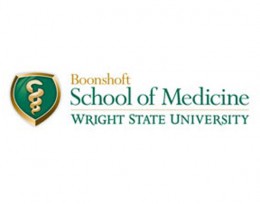 Graduating medical students in the Wright State University Boonshoft School of Medicine learned today which residency programs they will enter after receiving their medical degrees in May.
Graduating medical students in the Wright State University Boonshoft School of Medicine learned today which residency programs they will enter after receiving their medical degrees in May.
A long-standing tradition at medical schools across the country, Match Day is a highly anticipated event that represents the beginning of the next phase of a medical student’s life: the day they learn where they are heading as a new doctor to receive advanced clinical training in a residency program.
Gathered with family, friends and other supporters in the Student Union Apollo Room on campus, the students took part in a national event that has become a rite of passage for those on the brink of becoming physicians.
Each year, the National Resident Matching Program (NRMP) analyzes the preferences of roughly 16,000 U.S. medical students, 15,000 other applicants and 4,200 residency programs with 24,000 open positions. Based on this analysis, the NRMP determines who will fill each position, and the results are released nationwide at the same time.
Depending on where they match, students will spend the next three to five years as residents receiving advanced training in a primary care field or one of dozens of medical specialties. Wright State students matched in outstanding programs in Dayton, throughout Ohio, and across the country, including Case Western Reserve, the Cleveland Clinic, Stanford University and the University of Chicago Medical Center.
The number of Wright State graduates choosing to enter primary care jumped substantially, with those choosing family medicine up nearly 69 percent over 2011. This is significant because the number of U.S. medical students entering family practice training programs has dropped more than 50 percent over the last decade, while the need for family practice physicians has continued to grow
More than one third of the Wright State graduates will remain in Ohio during residency, and more than half (52.6 percent) will enter a primary care field (Family Medicine: 23.2 percent; Internal Medicine: 16.8 percent; Internal Medicine-Pediatrics: 2.1 percent; and Pediatrics: 10.5 percent). The rest matched in 12 other specialties: Anesthesiology: 5.3 percent; Dermatology: 1.1 percent; Emergency Medicine: 14.7 percent; Neurology: 1.1 percent; Obstetrics and Gynecology: 4.2 percent; Orthopaedic Surgery: 1.1 percent; Otolaryngology: 2.1 percent; Physical Medicine and Rehabilitation: 1.1 percent; Plastic Surgery (Integrated): 1.1 percent; Psychiatry: 6.3 percent; Radiation-Oncology: 1.1 percent; and Surgery-General: 8.4 percent.
In addition, 53 students matched into Wright State residencies, 41 of those coming to Dayton from medical schools across the nation and worldwide. Graduates of such prestigious medical schools as the University of North Carolina at Chapel Hill, Jefferson Medical College, and the University of Wisconsin will be coming to the Dayton region to complete their medical training at Wright State.
According to the NMRP, U.S. medical school seniors made up 15,712 of the 22,934 applicants who were successfully matched to first-year residency positions this year. The number of applicants in this year’s Main Residency Match was 38,377. These individuals applied for 26,772 positions, an increase of 614 over 2011.

 Milling around
Milling around  Wright State recognizes Nursing Professor Kim Ringo for advancing international student success
Wright State recognizes Nursing Professor Kim Ringo for advancing international student success  Wright State honors graduating students for distinguished doctoral dissertations
Wright State honors graduating students for distinguished doctoral dissertations  Top 10 Newsroom videos of 2025
Top 10 Newsroom videos of 2025  Museum-quality replica of historic Hawthorn Hill donated to Wright State
Museum-quality replica of historic Hawthorn Hill donated to Wright State 